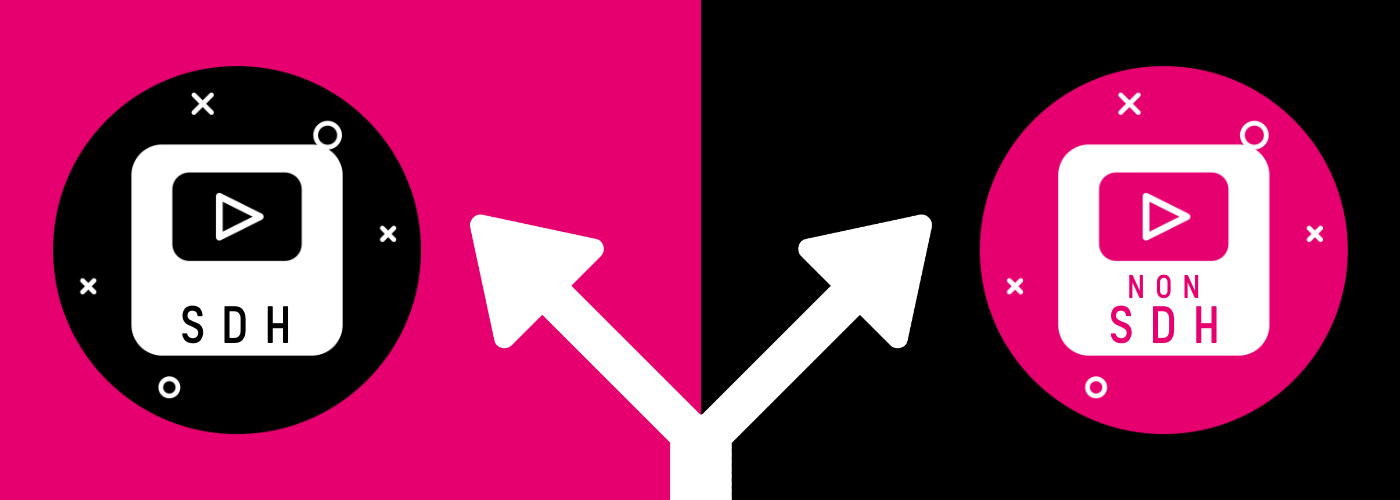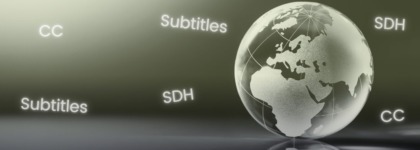SDH vs. non-SDH Subtitles: When to Use Them
Updated: March 1, 2023
How to Write WebVTT Files [Free Guide]
Do you ever watch a television show on a streaming platform with the subtitles turned on?
Perhaps it’s an anime, and the subtitles translate Japanese dialogue into English. Or maybe it’s the English-language cerebral drama topping the watchlists of everyone you know. Well, hang on. Since the show’s in English, maybe they’re captions; they have speaker IDs and sound effects transcribed, after all. Subtitles don’t usually include those, right?
The answer is yes and no. There are two different types of subtitles: SDH and non-SDH. While these subtitles share many of the same characteristics, they serve different functions for their intended audiences. In this article, we’ll explore what SDH and non-SDH mean, when each is used, and how they differ from closed captions.
What are SDH subtitles?
SDH stands for subtitles for the d/Deaf and hard of hearing. These subtitles assume the end user cannot hear the dialogue and include important non-dialogue information such as sound effects, music, and speaker identification. In the United States and Canada, SDH traditionally assumes the end user cannot understand the language being spoken, as is typical with subtitles. This isn’t the case in places like the UK, where “subtitles” can also refer to “captions”.
What are non-SDH subtitles?
Non-SDH, or non-subtitles for the d/Deaf and hard of hearing, are traditionally referred to as just “subtitles.” Non-SDH assumes the end user can hear the dialogue and understand the non-dialogue information but cannot understand the language. The only transcribed element of non-SDH is dialogue. On-screen graphics or words may also be transcribed, when time allows for the translation of these elements.
Optional transcribed elements: On-screen graphics or text, when time allows.
How do non-SDH subtitles differ from SDH subtitles?
Both SDH and non-SDH subtitling types have the same technical features in terms of characters per row, line limits, timing, and visual appearances. Both also have the goal of providing translations of dialogue into another language. The main difference lies within their audience assumptions. Put simply, non-SDH is targeted to a hearing audience, whereas SDH is targeted to a d/Deaf or hard of hearing audience.
How to write your own subtitle and caption files 🙌
Now that we’ve defined SDH and non-SDH subtitles and outlined the differences between the two, let’s consider the right use cases for each. Determining which format is best can be tricky and nuanced! We have outlined several fictional scenarios to demonstrate the considerations you should make when deciding what is best for your industry and content type.
When to use SDH Subtitles
Scenario: Blu-ray release of sitcom requires a CC-to-SDH reformat
A major television network is releasing a special 10th-anniversary edition of a popular sitcom that formerly aired on their network. This edition will only be released in the US, but the studio handling the production of the Blu-ray has discovered that the closed caption files they have for the sitcom will be incompatible with this DVD type. They decide to have their broadcast closed caption files reformatted into SDH subtitle files to provide d/Deaf and hard of hearing audiences with a closed captioning alternative.
Scenario: SDH subtitles for virtual event recordings
US-based Company XY has been gearing up for its annual virtual event extravaganza. The event includes workshops, lectures, and webinars from industry experts and is a great opportunity for employees and customers to learn. While they’ve typically used their video platform’s auto caption feature for the live portion, they’ve received feedback from d/Deaf and hard of hearing attendees that they’d be interested in cleaner English captions or subtitles for on-demand event content after the fact. XY decides on English SDH subtitles for their post-event on-demand content so that they can meet the needs of their English-speaking d/Deaf and hard of hearing audience members, and subsequently use the SDH subtitles to later translate and better reach d/Deaf and hard of hearing multilingual audience members as well.
When to use non-SDH subtitles
Scenario: MNC goes global with non-SDH Subtitles
Multinational Company X is headquartered in the US. X recently expanded their reach by setting up office locations in South America, Europe, and Asia. They only have training and corporate communication videos in English, but they recognize their need for localized subtitles.
Scenario: MOOC expansion supported by non-SDH subtitles
University of Z is based in the US, and has been offering massive open online courses (MOOCs) in addition to traditional in-person classes for several years now. They recently decided to expand their offerings to reach not only English learners, but multilingual students as well. They’ve chosen to include non-SDH subtitles on all of their MOOC video content in Spanish, Portuguese, Mandarin, French, and German as a starting point.
When to use both SDH and non-SDH subtitles
Scenario: Big OTT release requires SDH and non-SDH subtitles
Production Company Y is readying their newest sci-fi show for exclusive release on Very Big OTT Streaming Platform. Former shows they’ve created have gone to major broadcast networks in the US, so they’ve only ever ordered English closed captions to meet FCC requirements. Their post-production supervisors have learned that Very Big OTT requires both English SDH subtitles and non-SDH subtitles.
What about closed captions?
So how do closed captions factor into all of this? Captions are closely related to subtitles, and there’s often confusion between the two, because SDH subtitles are often used in their place by media that doesn’t support broadcast closed captions, such as digital connections like HDMI and OTT media platforms. SDH also has the ability to visually mimic closed captions, further muddling how each are defined. However, captions and SDH differ in a few ways, including:
- SDH subtitles have more room for transcription, supporting 42 characters per row to CC’s 32 characters per row limit.
- SDH subtitles are timed much tighter to the audio than closed captions.
- SDH subtitles vary between fonts, colors, and styles, and can look different depending on the media player or platform.






